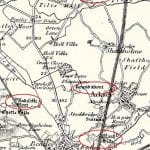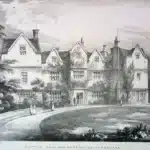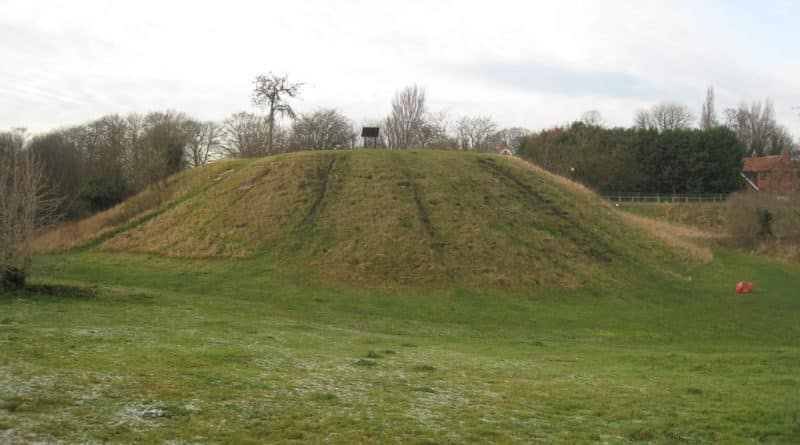Fortifications in and around Doncaster
Doncaster and the villages surrounding it were home to a large number of fortifications in the later medieval era. The best known of these are the remains of the stone castles at Conisbrough and Tickhill. However, these are not the only examples of fortified structures in and around the town in the period.
Overview of defensive structures in or near Doncaster
Adwick-le-Street
Just to the north of Doncaster lay the village of Adwick-le-Street. Within this village are remains of several fortified structures. Two of these are clearly linked: one being a successor to the other. The third is just a few hundred metres away and was contemporary to both of its near neighbours. In addition to these are additional moated sites in the area called Round about Moat, Moat Hills and Tilts Moat. Read about Adwick Hall here. Read about Hangthwaite Castle here. Read more about Radcliffe Moat here.

Thorne
To the north east of Doncaster is the town of Thorne, which now is a civil parish within the Doncaster region. At Thorne there was a fortification at Peel Hill. Read more about Peel Hill in Thorne here.
Conisbrough and Tickhill
To the south of Doncaster lay the Honour of Tickhill, home to a castle which remains relatively intact to this day. To the west of Tickhill lay Conisbrough. Conisbrough Castle itself is well known and is one of the largest and impressive ston castles in Yorkshire. It was not the only fortification within the vicinity though, additional defensive structures are known to have been situated nearby at Mexborough. Read about Conisbrough Castle here. Read about Tickhill Castle here.
Doncaster Town Defences
Doncaster itself once was home to a castle, the remains of which are now difficult to spot even with a trained eye. The castle itself was not the only defence within the town though. Earthworks and bars [gates] formed a defensive perimeter around the town. It is also quite conceivable that some of the major buildings within the township were designed with defensive features, though there are few visible signs of any of these buildings anymore so that is supposition.
Adwick Hall – Hangthwaite Castle – Radcliffe Moat – Peel Hill in Thorne.
Adwick Hall. A Fortified Manor House in Yorkshire
Adwick Hall was just to the north of Doncaster. There are limited remains or documents available today relating to the site. There are features which support the previous existence of a moat around a medieval home: which may have been fortified.
Jean Le Patourel noted in her monograph on Moated Structures in Medieval Yorkshire that Adwick Hall was a Manor with gardens, held in 1301 by Alice du Lound. Evidence to support the suggestion that the Manor had a moat comes from visible remnants of a moat or ditch ranging from 4 to 6 metres in width going around three sides of the original site.
To date it has not been fully examined. Google Maps shows the site, with the outlines of earlier buildings and potential moats showing. Gatehouse Gazetter provides some additional information.
The Medieval structure no longer exists. It seems to have been superceded by a Tudor era Hall which was linked to the Washington family. This family is directly linked to George Washington who became the first President of the United States of America.

Heritage Gateway – Adwick Hall
Adwick Hall – Hangthwaite Castle – Radcliffe Moat – Peel Hill in Thorne.
Hangthwaite Castle also known locally as Castle Hills
Note: there is another Castle Hills within the Doncaster district. This was the site of Mexborough Castle which is 11 miles the south west of Hangthwaite, close to Conisborough Castle.
Hangthwaite was a motte and bailey structure built in the 11th century. It was constructed for Nigel Fossard who held the land from the Count of Mortain. Situated just to the south east of Adwick-le-Street and 4 miles north of Doncaster, the site overlooks and protected the Great North Road which passes to the castles east.
The castle consisted of a motte that was 4-5 metres high along with an inner and outer bailey.
The inner bailey at Hangthwaite Castle was to the north of the motte and was roughly 30 metres across. The inner bailey was surrounded by a rampart approximately 1.5 metres high, with a ditch on the outside, and in some places a double ditch.
The outer bailey lay mainly to the east of the castle and was roughly 70 metres by 40 metres.
The western side of the motte has a rampart extending from it which suggests that this was a defndable entrance to the motte.
To the east of Hangthwaite Castle was a village which has long since been abandonded.
Hangthwaite, also spelt Langthwaite at times, is 8 miles north east of Conisborough Castle and 11 miles south west of the de Warenne fortification at Peel Hill, Thorne.
Hangthwaite was quite a substantial earthwork. It was superseded by a later stone built castle, called Radcliffe Moat, which was built 500 metres to the north east of the motte and bailey site.
Castles UK – Hangthwaite Castle / Castle Hills
Wikipedia – Hangthwaite Castle / Castle Hills
Historic England – Castle Hills
Gatehouse Gazetteer – Castle Hills
Adwick Hall – Hangthwaite Castle – Radcliffe Moat – Peel Hill in Thorne.
Radcliffe Moat
Radcliffe Moat was built 500 metres to he north east of the motte and bailey castle known as Hangthwaite Castle and superceded it as the primary defensible structure for the manor of Hangthwaite / Langthwaite.
It was built in the 13th century. Little is known about the building itself as there are no visible outlines and the site has not yet been subject to a detailed archaeological survey. However, written references from 1828 refer to a manor house at the site having been demolished in the late 18th century so we can assume that it was a fortified manor house. Records also show that the manor was sold in the reign of Elizabeth I and previous landholders had, presumably for many years, been the de Langthwaite family.
The site itself is a four sided, moated island. Built on the banks of Langthwaite Dike, the site is a natural mound around which aa moat was dug which was filled with water from the Dike. Today some of this moat remains visible and is usually waterlogged rather than being full of water.
The islands sides measure 55 metres on the north bank, 65 metres on the east, 50 metres on the south, and 45 metres to the west. An inner banking was constructed around the moat to provide additional defensive strength.
Heritage Gateway – Radcliffe Moat
Historic England – Radcliffe Moat
Adwick Hall – Hangthwaite Castle – Radcliffe Moat – Peel Hill in Thorne.
Peel Hill motte and bailey castle, Thorne
Peel Hill is a Motte and Bailey castle that was constructed in Thorne near Doncaster.
Remains of Peel Hil Motte and Bailey are shown in the video above. The Motte rises some 8 metres high and is 15 metres in diameter at the top. Around this Motte is a steep sided ditch to enhance it’s defensive strength. A Bailey was in place to the south. It is known that the bailey contained some substantial buildings in the medieval era as they are referenced in documents from the 16th and 17th centuries.
Peel Hill was referred to in John Leland’s itineraries (1534) which note it was then being used as a prison.
by the church garth of Thorne is a praty pile or castelet, well diked, now used for a prison for offenders in the forestes
John Leland, Itineraries
The Castle then fell into disrepair and in references from Casson in 1829 state that only the foundations remained visible at that time. His description likens Peel Hill to being a smaller version of Conisbrough in terms of its layout and design. This would make sense as the Motte and Bailey was developed by the same family, the de Warenne’s. His description of the foundations suggest that the wall of the tower built on the Motte were between 4 and 5 feet thick and made of rounded stone and cement. It also suggests that the tower had buttresses on three sides.
Some 50 metres to the south of the Motte can be found a church which was founded in the 12th century by the de Warenne family. Though it has been altered over the centuries, parts of the 12th century build remain visible. It is suggested that the gatehouse to the Bailey was close to this church.
Historic England – Peel Hill motte and bailey castle, Thorne.
Heritage Gateway – Peel Hill Motte and Bailey at Thorne
Gatehouse Gazetteer – Thorne, Peel Hill
History of Thorne – Peel Hill Motte and Bailey
Adwick Hall – Hangthwaite Castle – Radcliffe Moat – Peel Hill in Thorne.
Records relating to Langthwaite / Hangthwaite Manor and Castle(s)
Domesday Book
The Manor of Langthwaite is referred to in the Domesday Book. The extract can be downloaded from the National Archives website. [Free if you register which is free in itself for UK residents, £3.50 otherwise}
Grant of Manor
The Manor was granted to Hugh de Langthwaite, so on Sir William de Langthwaite in March 1276.
Sir Roger fitzThomas ‘, witness (together with his brother Sir William) to grant of the manor of Langthwaite for life, dated at Langthwaite, 2 Ides of Mar 1276:
‘ Hugh de Langthewait, son and heir of Sir William de Langthewait, to Sir Robert de Eueringham, then rector of the church of Berkyn. The manor of Langthwaite with all appurtenances; all his land in
Adwick le Street; all his land and rent in Doncaster between Chesewold Bridge and the mills bridge; all his land and rent in Wheatley; ½ mark annual rent in Sprotborough which is owed by Sir William fitzThomas. For term of life. Annual rent of 19s. 8d., of which 5s. 4d. to the chief lord of the fee, Peter de Mallo Lacu, 13s. 4d. to the Abbot of St. Mary’s, York, 1s. to Sir Stephen le Waleis, lord of Bourk; and suit of court to the Court of Sir Peter de Mallo Lacu at Doncaster.Witnesses: Sir William fitzThomas, Sir John de Romundby, Sir Roger fitzThomas, Sir Richard de Romundby, kts., Sir William de Veyley, rector of Owston, Sir Henry de Normanton Henry chaplain of
Adwick le Street, Ralph de Langthewait, Thomas de Scauceby, William de Newesum, Henry de Rockeleye, Adam de Langthewait, Adam Maldut and many others. ‘PRO, Sheffield Archives: Cooke of Wheatley Muniments, CWM/131[12]
Property Owners
Yorkshire Archaeological Journal notes that the village had 7 proprieters assessed for tax purposes in 1279.
ANGTHWAITE or LANGTHWAITE c.554069
DB NV LS : 31s. PT (1379) 25. Relief (1352) 50% (1354) 16%.
In 1279 seven proprietors were assessed here. Although the 1st ed. 6″ map had ‘Langthwaite’ as the township name, the lane leading towards Castle Hills and ‘moats’ is ‘Hangthwaite Lane’. There are 422 acres in the township. The village site seems to lie near the moats, but the railway bisects the site and partly obscures it. But see Hunter, op. cit., ii, p. 490. There is an extent of the manor in Y.I., iii, p. 84 (1298), when about one third of the present acreage was demesne arable.
Held by Sir William de Sprotteburg
In the 26th year of the reign [1298] of Edward I Hangthwaite is noted in an IPM.
Inq. made at York on Wednesday after the Translation of St. Thomas the Martyr, 26 Edw. I.
Benteley. The manor (extent given), including a pasture called Northwod, held jointly with Eva his wife, by the gift of Adam de Novo Mercato to them and the heirs of the said Robert, of the king in chief, as of the honour of the castle of Tikhill, now in the king’s hand, by service of rendering 40s. for the guard of the said castle, 6s. 8d. for fine of the wapentake, and 2s. for ‘Waytemete’ and ‘Schirrefftothe.’
Hagenthweyt. The manor (extent given) jointly held as above of Sir William son of William de Sprotteburg by homage and service of 1d., and the foreign service pertaining thereto, of the gift and enfeoffment of one Peter de Cestria.
He died at Nettelstede on Thursday after St. Dunstan last. Heir as above, aged 17 at the feast of the Nativity of St. John the Baptist last.Writ, 20 July, 26 Edw. I.
‘Inquisitions Post Mortem, Edward I, File 85’, in Calendar of Inquisitions Post Mortem: Volume 3, Edward I, ed. J.E.E.S. Sharp, A.E. Stamp( London, 1912), British History Online . Entry 475.
Robert Tibetot
From the reign of King Edward III there is an IPM showing the Manor to be held by Robert Tibetot from John Fiz William.
Inq. taken at Bentley, 17 May, 46 Edward III.
Haunthwayt. The manor, held of John Fiz William by homage and fealty and service of rendering 8s. 1d. yearly. About 3 years ago he granted the manor by charter to the said John for life at a yearly rent of 5 marks.
A. E. Stamp, J. B. W. Chapman, M. C. B. Dawes, D. B. Wardle, ‘Inquisitions Post Mortem, Edward III, File 230’, in Calendar of Inquisitions Post Mortem: Volume 13, Edward III( London, 1954), British History Online. Entry 212.
John Gryseacres
In the 17th year of the reign of King Henry VII an IPM noted that a John Gryseacres held the Manor of Langthwaite from Richard Woderove, knight. It was worth 10l (pounds) and he paid a rent of 1d (pence) annually for ‘all service’.
JOHN GRYSEACRES.
Writ, 21 July, 16 Henry VII; inquisition, 20 January, 17 Henry VII.
The said John Grysakyrs died 13 July last past seised of the under-mentioned manors, &c. in fee. John Grisakyrs, aged 40 and more, is his son and heir.
A messuage, 40a. land, 30a. meadow and 40a. pasture, in Tils, in the parish of Doncastre, worth 10l. held of Richard Woderove, knight, as of his manor of Langwhait, by fealty and 1d. rent yearly, for all service.
Maskelyne, H. C. Maxwell Lyte, ‘Inquisitions Post Mortem, Henry VII, Entries 551-600’, in Calendar of Inquisitions Post Mortem: Series 2, Volume 2, Henry VII( London, 1915), British History Online Entry 571.
Adwick Hall – Hangthwaite Castle – Radcliffe Moat – Peel Hill in Thorne.
Links
Arksey Village – details of four moated sites in and close to the village of Arksey which is to the north of Doncaster.
Adwick Hall – Hangthwaite Castle – Radcliffe Moat – Peel Hill in Thorne.
Featured Image
Peel Hill motte and bailey castle, Thorne. Copyright Jonathan Thacker and licensed for reuse under this Creative Commons Licence.
